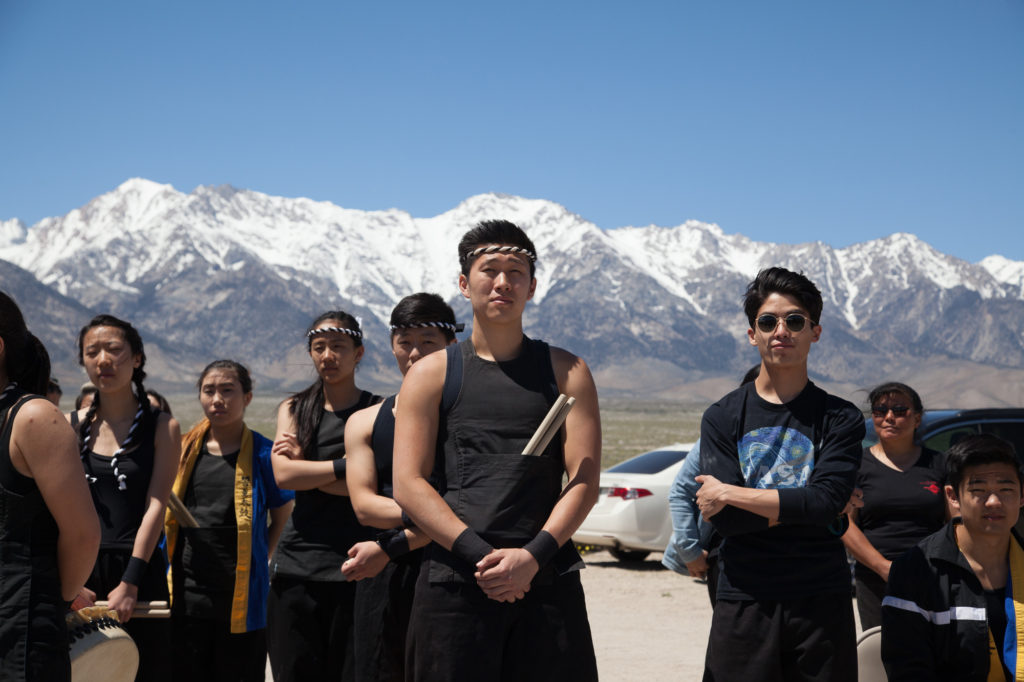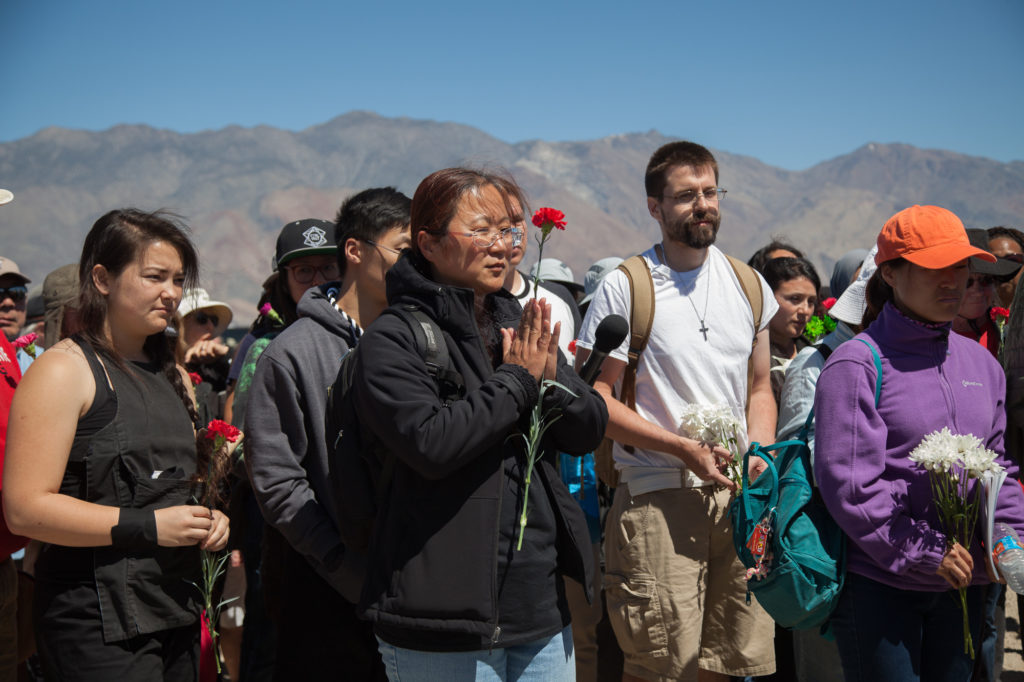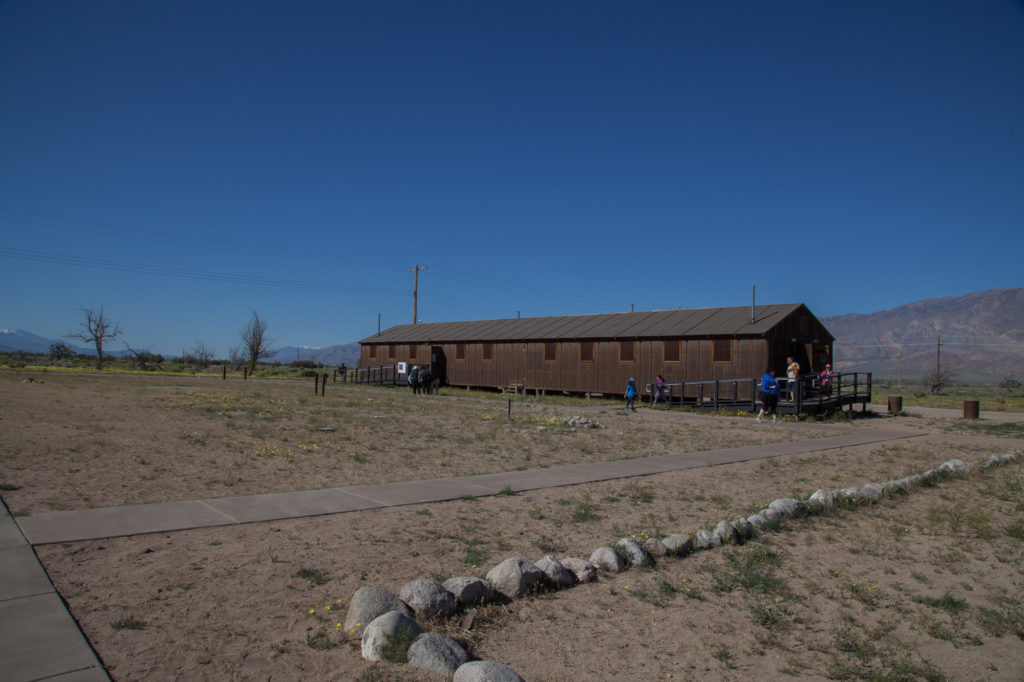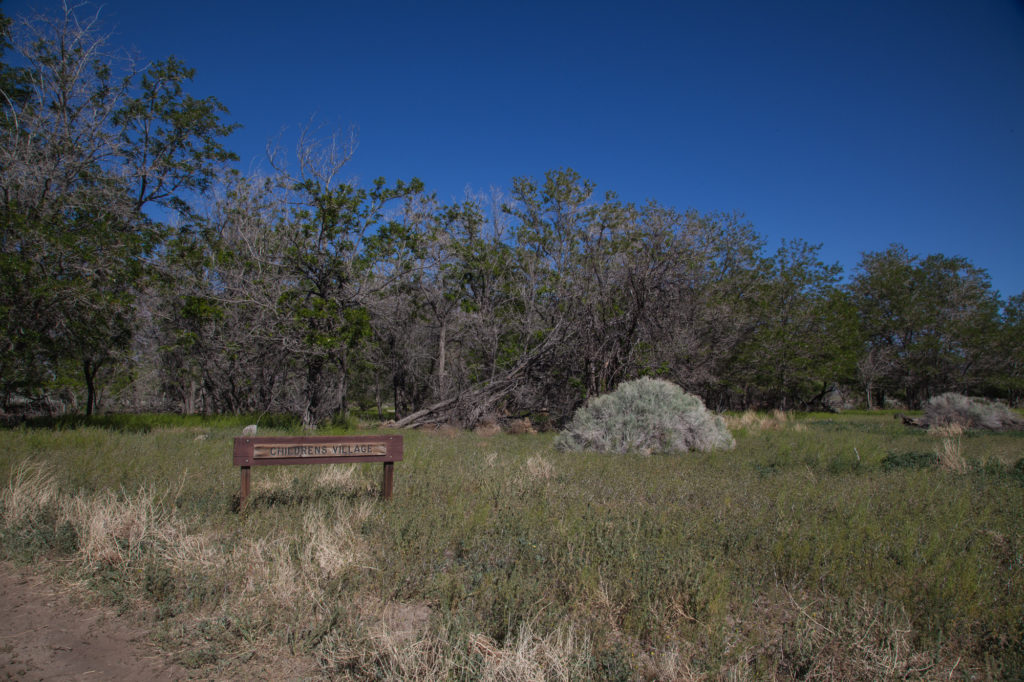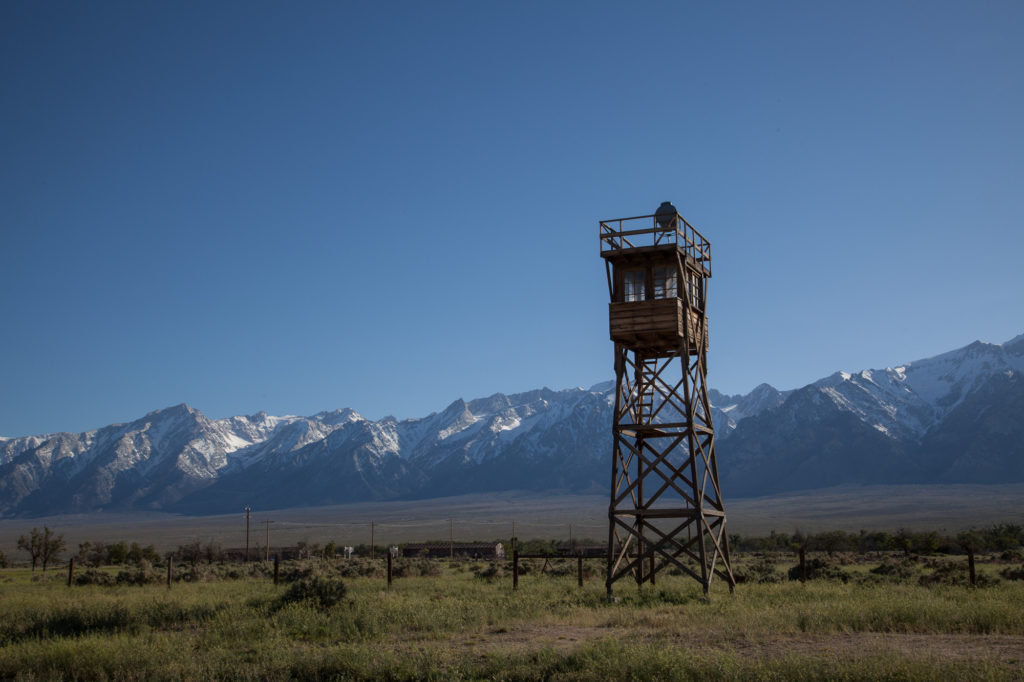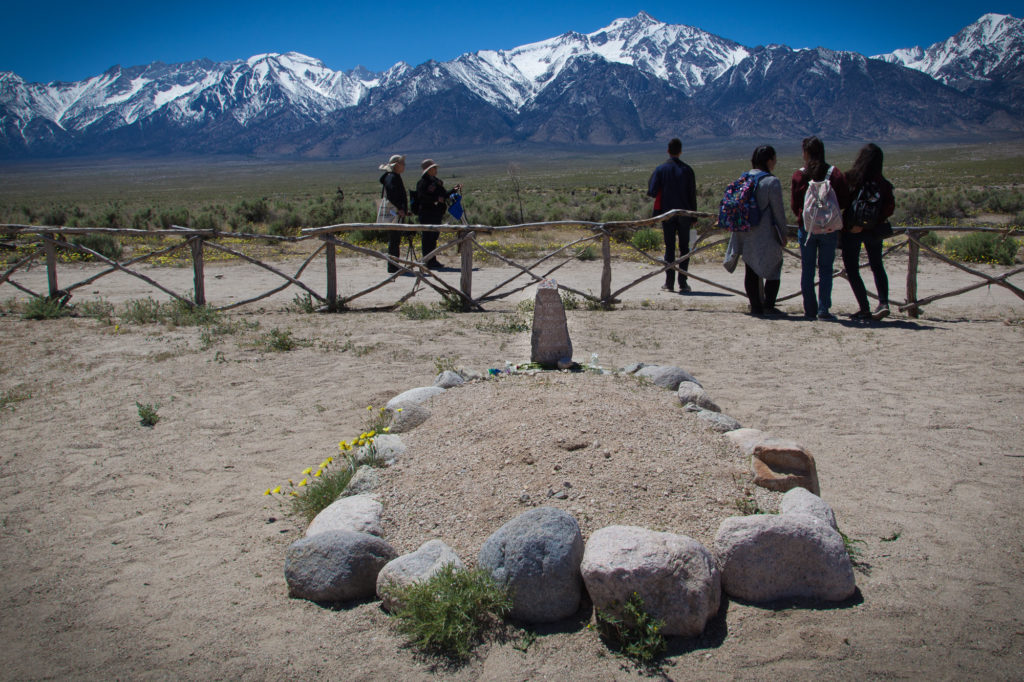
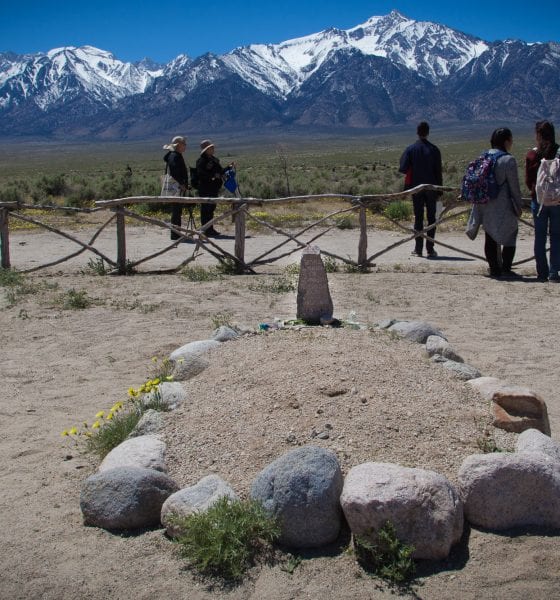
The Golden State of Hate
From Remembrance to Resistance: The 48th Manzanar Pilgrimage Photo Essay
From Remembrance to Resistance: The 48th Manzanar Pilgrimage.
A photo essay by Joanne Kim.

On April 30, 2017, the 48th Manzanar Pilgrimage took place, marking the 75th anniversary of Executive Order 9066, which authorized the forced removal of Japanese-Americans. Manzanar was the first concentration camp created by FDR’s order, and was located in a valley below the Eastern Sierras. Photo by Joanne Kim

Activist Pat Sakamoto, co-host of the 48th Manzanar Pilgrimage, whose mother was incarcerated at Manzanar. Photo by Joanne Kim

An estimated 2,000 people attended the 48th annual Manzanar Pilgrimage this year. Photo by Joanne Kim

First-timers to the Manzanar Pilgrimage raise their hands. Many new people were inspired to attend this year due to similarities between the Trump administration’s rhetoric and policies against immigrants and Muslims, and the fate of Japanese-Americans during WWII. Photo by Joanne Kim
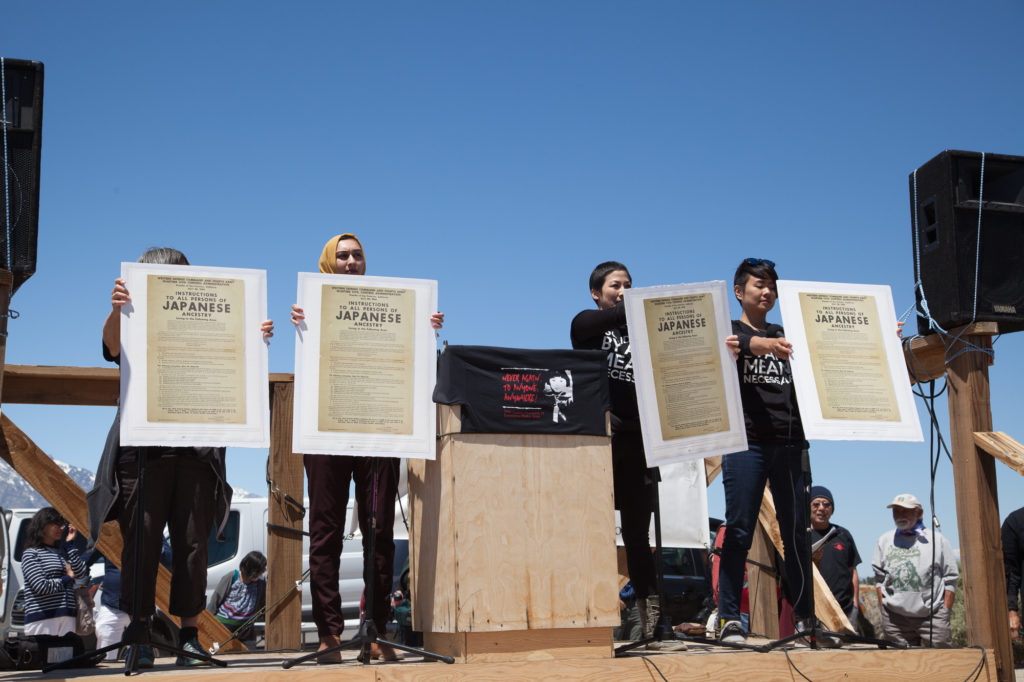
A performance by Vigilant Love, a solidarity community against violence and Islamophobia, which co-hosted the Manzanar Pilgrimage. From left: Kathy Masaoka, Sahar Pirzada, Traci Kato-Kiriyama, traci ishigo. Photo by Joanne Kim
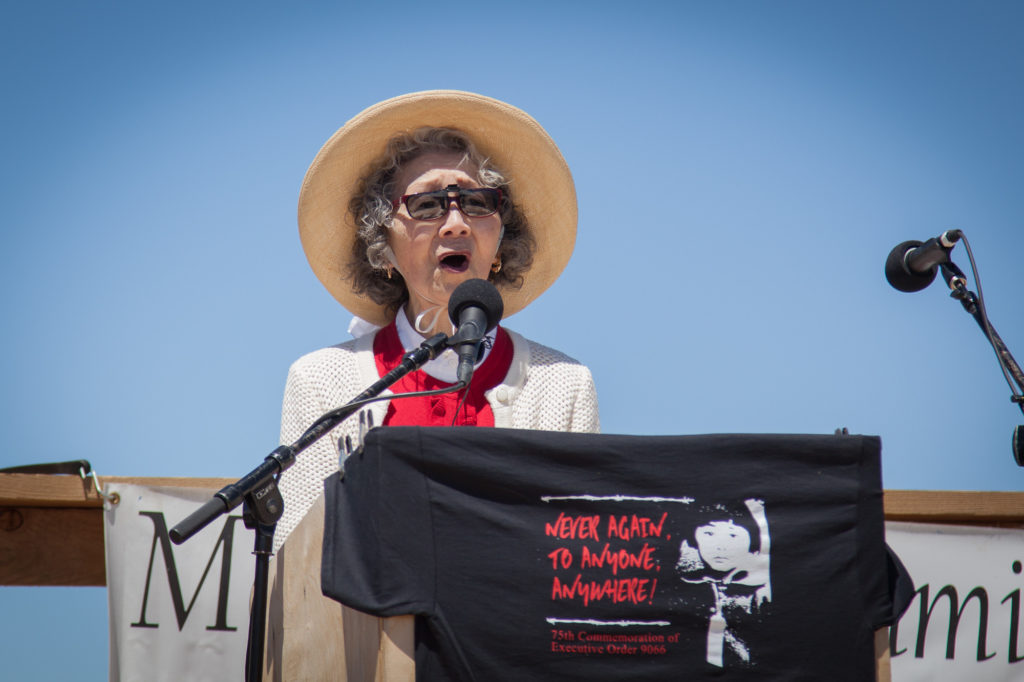
Mary Nomura, known as the “Songbird of Manzanar,” sings “When I Can,” a song written for her when she was a high school senior interned there. Photo by Joanne Kim

Eleven flags represent each of the 10 concentration camps and the 442nd Infantry Regiment. They are held by representatives each year at the Manzanar Pilgrimage to honor all of the internees, sites and veterans. Photo by Joanne Kim

Attendees of the 48th Manzanar Pilgrimage listen to the program inside the camp’s cemetery. Photo by Joanne Kim

Sahar Pirzada (center), of Vigilant Love. In the years since 9/11, the Manzanar Committee built strong relationships with the Muslim and Arab-American communities. Photo by Joanne Kim

146 incarcerees died at Manzanar. Most were cremated, and their ashes were buried here or sent to hometown cemeteries. Six graves remain, most reburied elsewhere by their families. Photo by Joanne Kim
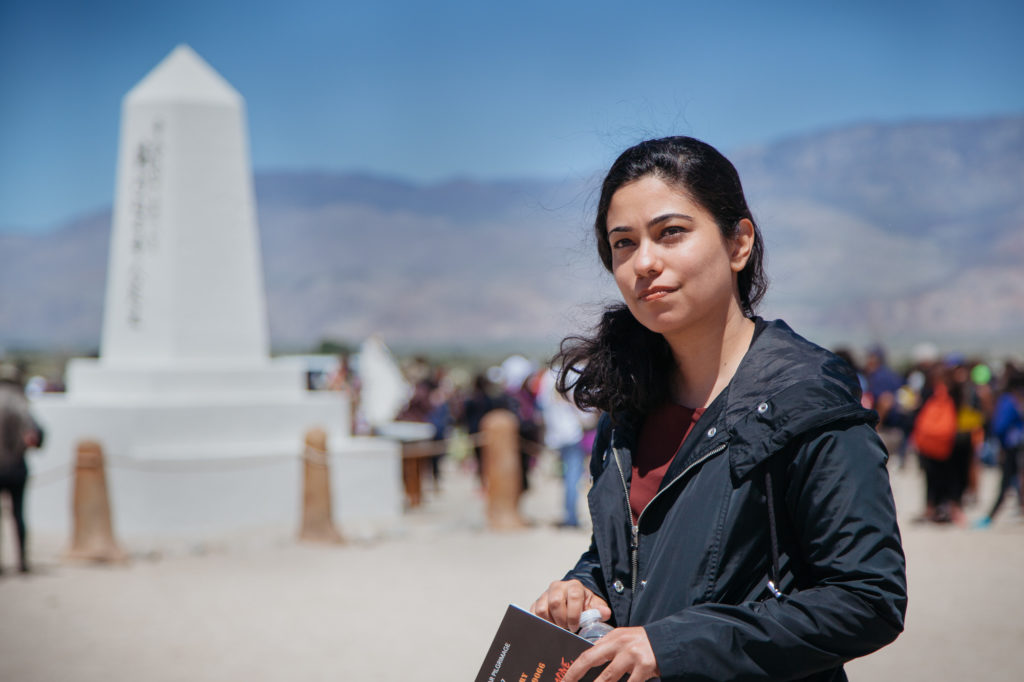
Asmaa Ahmed of the Council on American-Islamic Relations spoke as part of the 48th Annual Manzanar Pilgrimage’s program. She connected Roosevelt’s Executive Order 9066 with Trump’s Executive Order 13769, the travel ban on seven Muslim-majority countries. “The two orders are separated by a period of 75 years, but both were born out of the same culture of fear and prejudice.” Photo by Joanne Kim
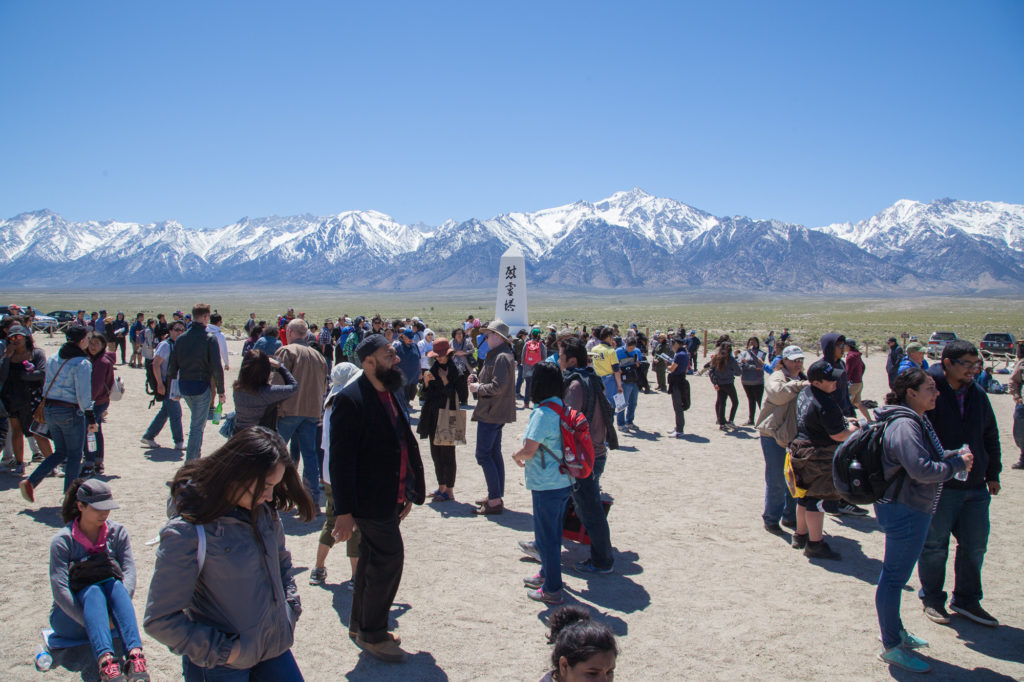
Attendees of the Manzanar Pilgrimage in the camp’s cemetery. In the middle stands “I Rei To/Soul Consoling Tower,” a monument by Ryozo Kado installed in August 1943 to honor those who are buried there. Families collectively paid for its construction. Photo by Joanne Kim
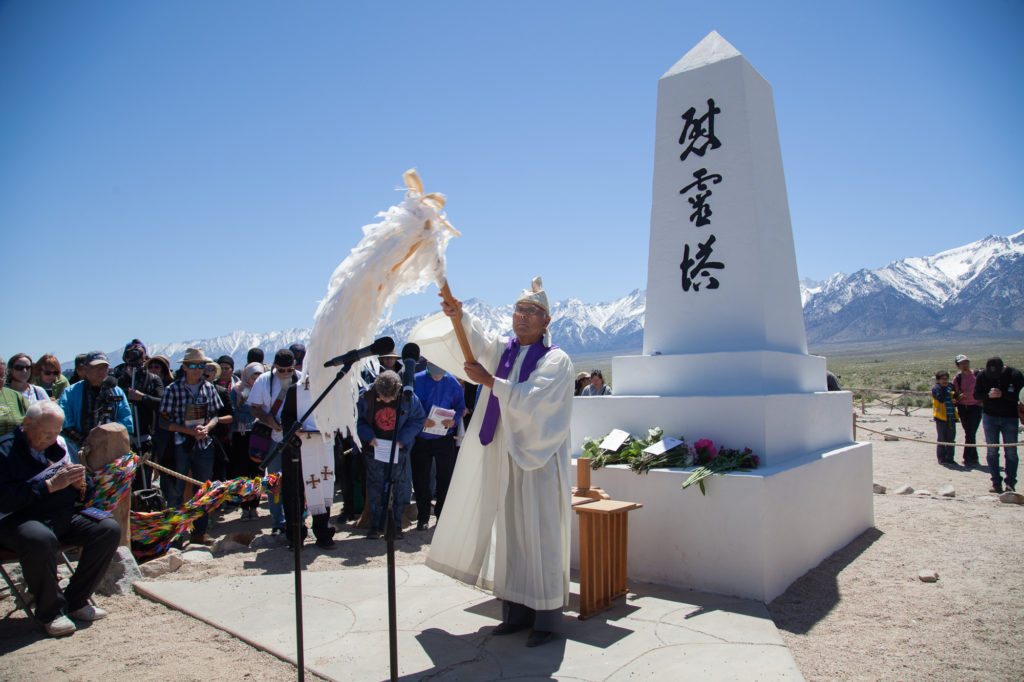
Rev. Alfred Yoshi Suyuki of the Konko Church leads a Shinto ceremony to begin the interfaith service at the I Rei To monument. Photo by Joanne Kim
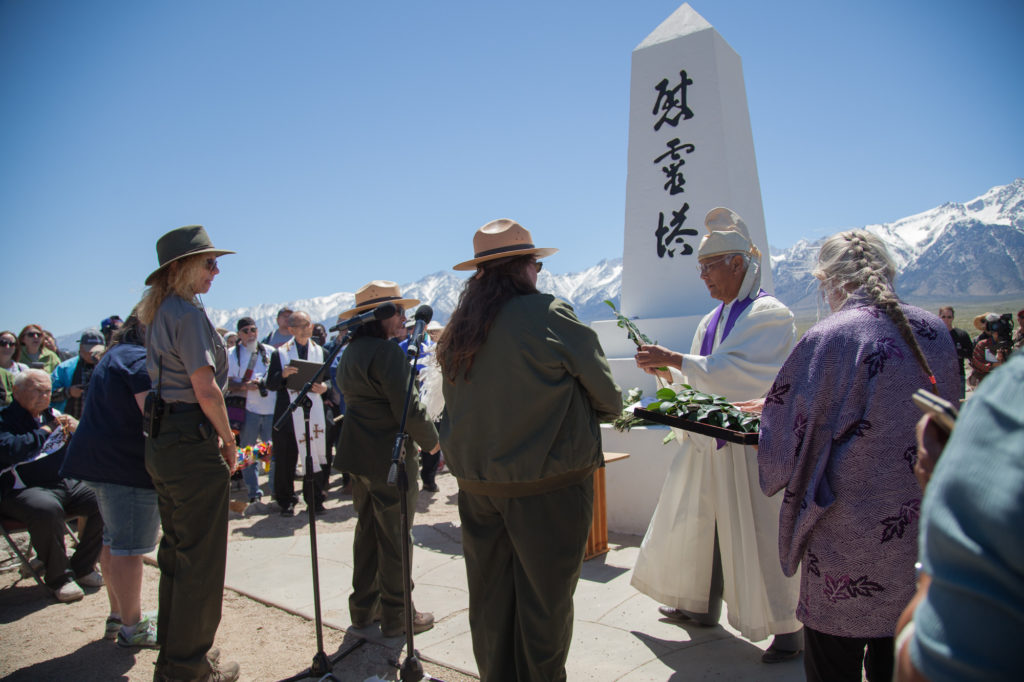
During the Shinto ceremony, National Park Rangers are given leaves to place on the I Rei To monument to honor those who were interned at Manzanar. Rangers worked with the Japanese-American community in creating the Manzanar Historic Site’s Museum and the re-creation of the barracks and buildings. Photo by Joanne Kim
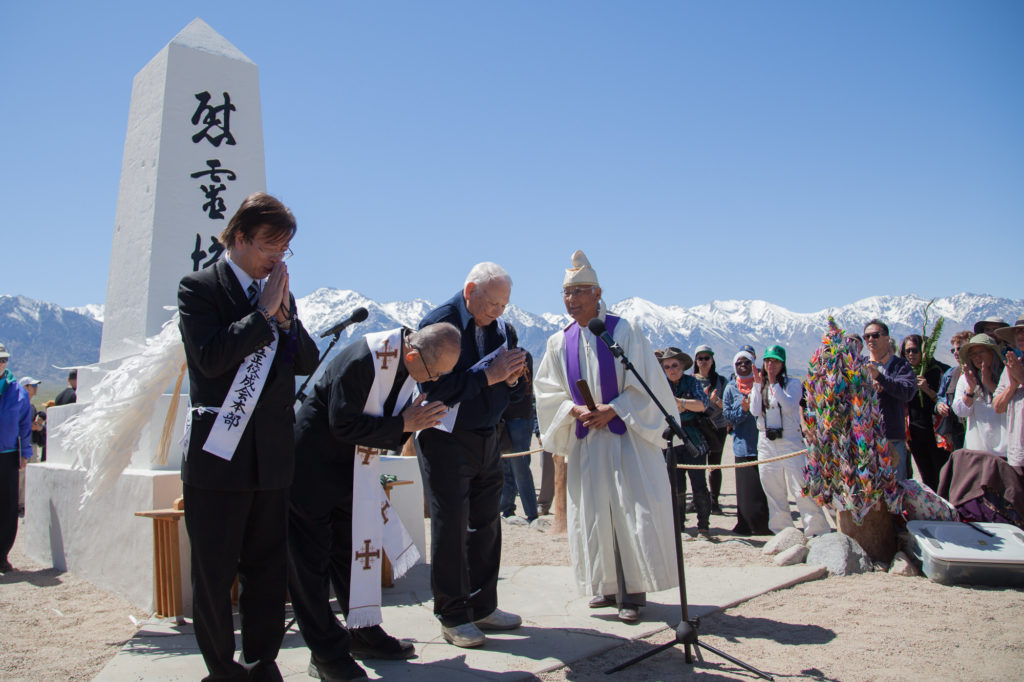
The interfaith service included Buddhist ministers from the Los Angeles Buddhist Temple Federation, Christian ministers and a Shinto minister. Photo by Joanne Kim
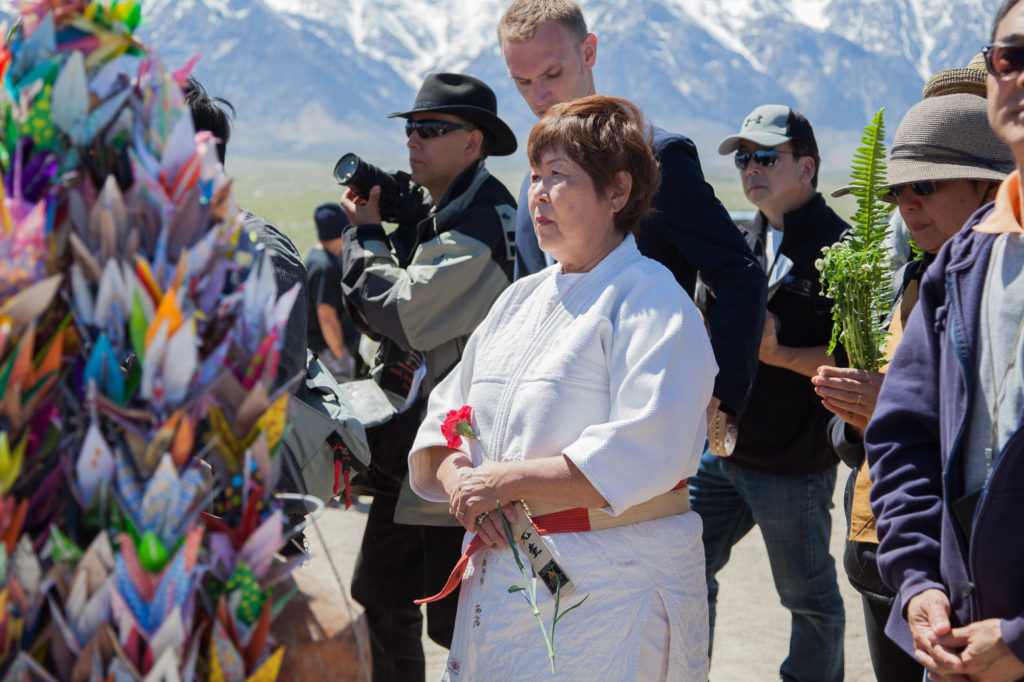
An attendee holds a flower during the interfaith service to place on the I Rei To tower to honor those who were interned at Manzanar. Photo by Joanne Kim

Attendees pray with the Buddhist ministers during the interfaith service at the Manzanar Pilgrimage. Photo by Joanne Kim

Buddhist minister reads a sutra as part of the interfaith service at the Manzanar Pilgrimage. Photo by Joanne Kim
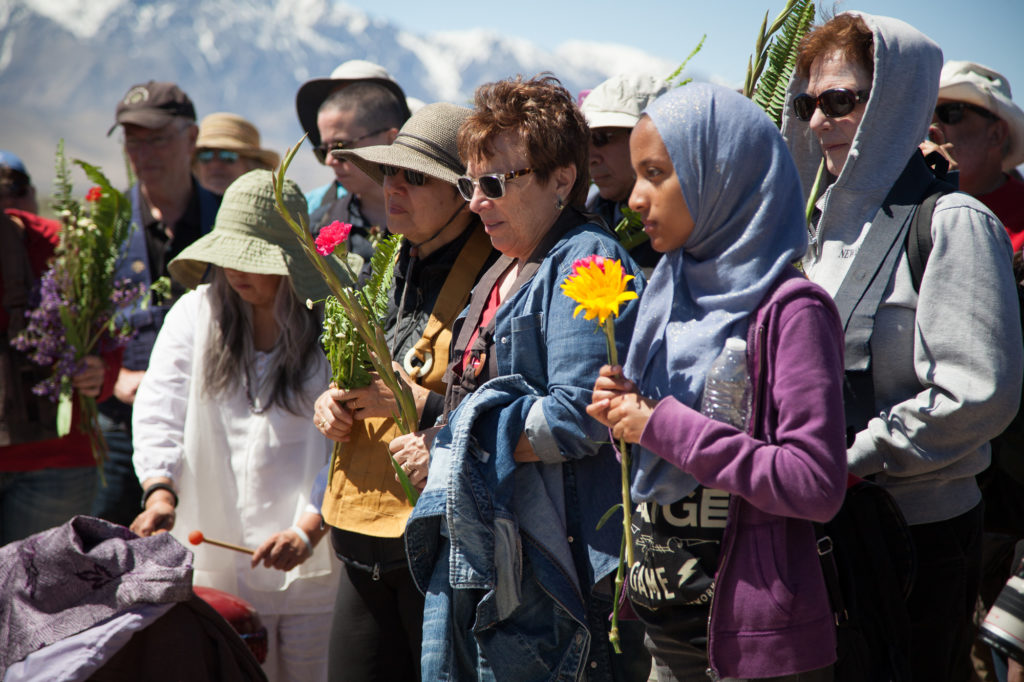
Attendees honor those who were interned at Manzanar during the interfaith service in the camp cemetery. Photo by Joanne Kim
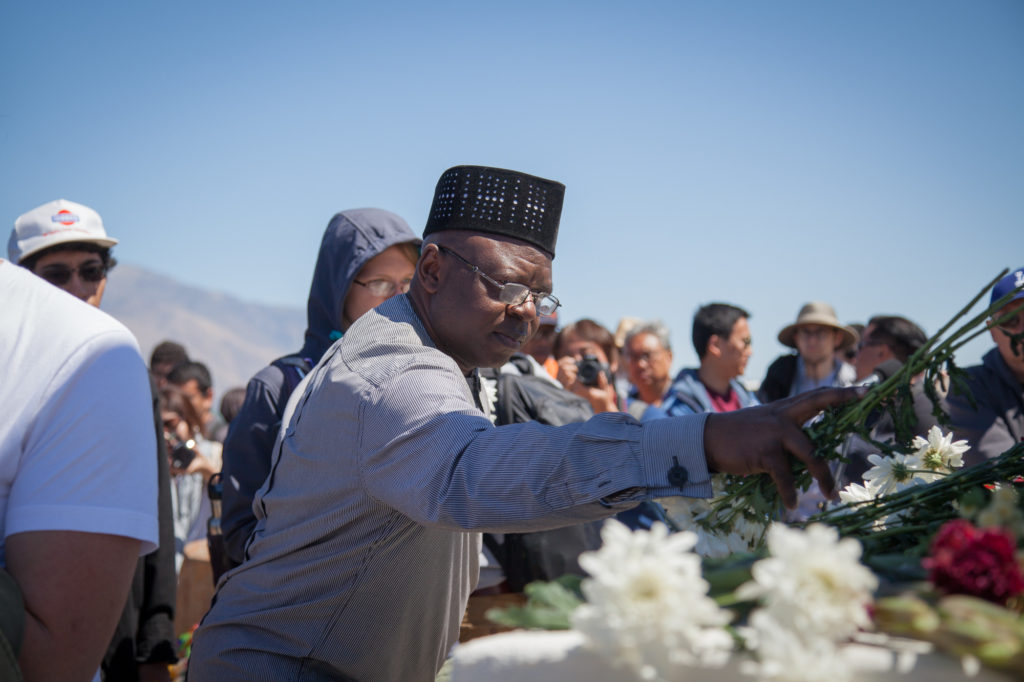
Attendee places a flower on the I Reo To/Soul Consoling Tower monument to honor those were forced to live in the Manzanar camp. Photo by Joanne Kim

Alan Nishio was born in the Manzanar concentration camp in 1945. He received the 2017 Sue Kunitomi Embrey Legacy Award for his lifetime’s work on a wide range of issues from the redress movement, to helping found UCLA’s Asian American Studies program, the fight for affordable housing and the preservation of Los Angele’s Little Tokyo. Photo by Joanne Kim
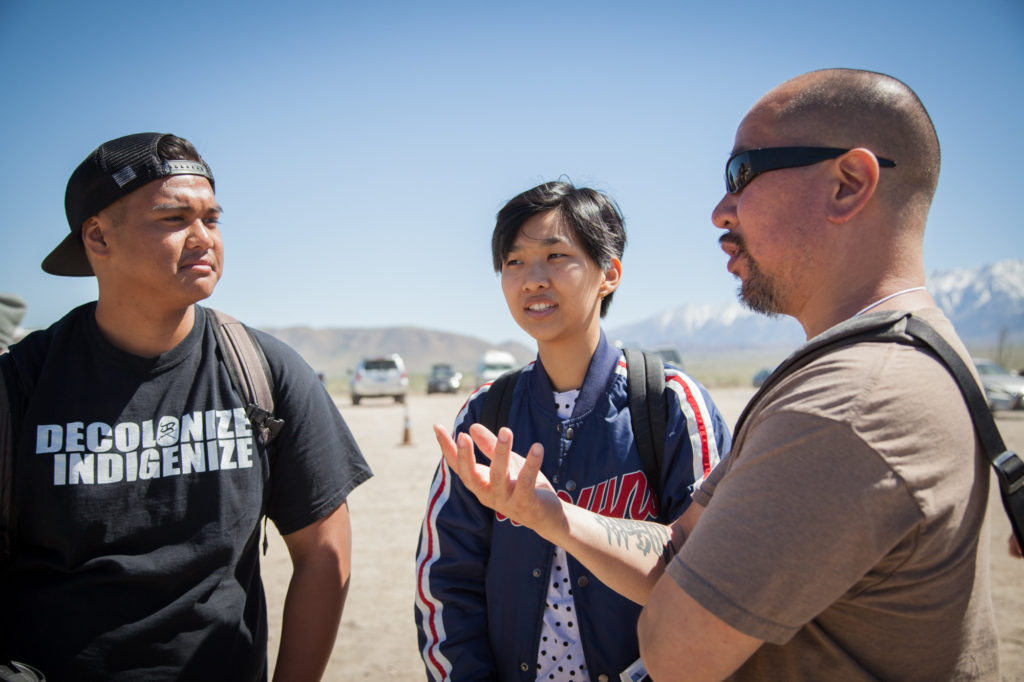
Steve Wong, Asian American Studies instructor, and two Pasadena City College students. Wong described the importance of coming to Manzanar and recognizing the danger of rhetoric that scapegoats marginalized groups for “military necessity” as happened with those of Japanese descent during WWII and is currently happening with Muslim groups under the Trump administration. Photo by Joanne Kim

Former Manzanar child internees Irene Hadeishi, left, and her sister Marge Taniwaki, right, in a re-created children’s room. In order to make the re-creations of living spaces accessible, National Parks was required to make the living quarters much nicer than what was the reality for Irene and Marge and other families. They slept in cots separated only by sheets from other families with floors made of wood beams with space between them so the dust would come up constantly from the ground into their eyes and mouths. Photo by Joanne Kim

Runners from the Manzanar 50/500, which is a relay run from Los Angeles to Manzanar in its 26th year. Mo Nishida (center), the founder of the run, felt it was a way to connect with the Native American communities and the cultural and spiritual uses of running. Danny Ramos (right) has been running with him for 10 years. Photo by Joanne Kim

View of the Eastern Sierras from the Manzanar concentration camp. The buildings from the camp were relocated around Lone Pine and other nearby towns, but the roads of the camp exist for visitors to walk through. Photo by Joanne Kim

Re-creation of the women’s latrine at Manzanar concentration camp. When re-creating some of the concentration camp’s buildings, Japanese-Americans who had been incarcerated at Manzanar felt it was extremely important to show people what life was like in the camp. There were no stalls in the toilets or the showers. Photo by Joanne Kim

Recreation of the dining hall at the Manzanar camp located in a valley below the Eastern Sierras (background). Photo by Joanne Kim
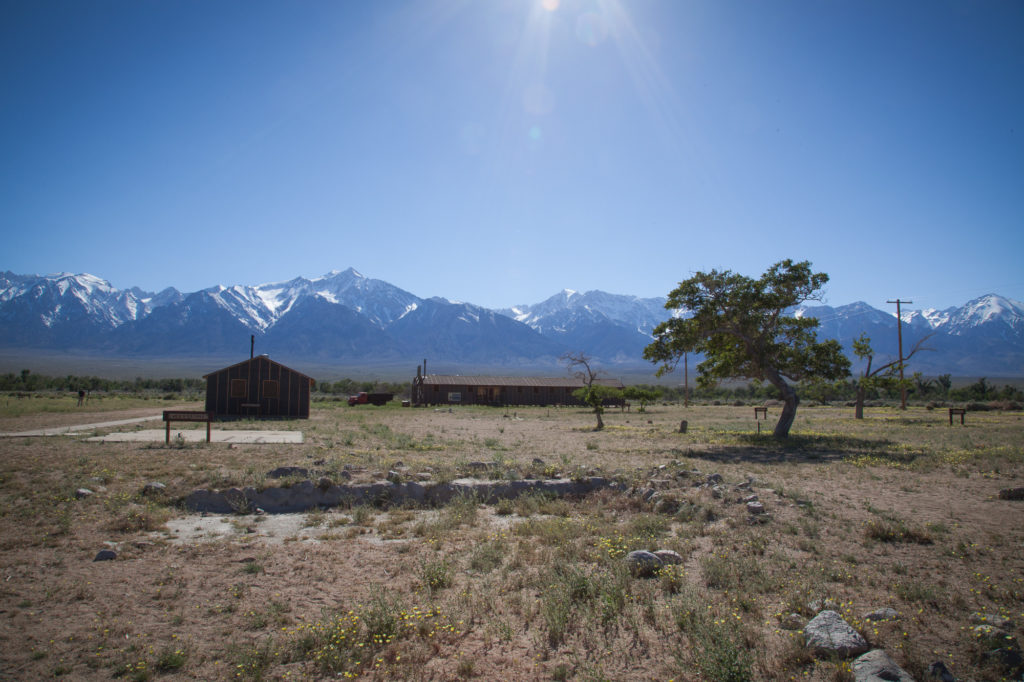
Recreation of the latrine and dining hall at the Manzanar concentration camp located in a valley below the Eastern Sierras (background). Photo by Joanne Kim

-

 Latest NewsDecember 8, 2025
Latest NewsDecember 8, 2025This L.A. Museum Is Standing Up to Trump’s Whitewashing, Vowing to ‘Scrub Nothing’
-

 Striking BackDecember 4, 2025
Striking BackDecember 4, 2025Home Care Workers Are Losing Minimum Wage Protections — and Fighting Back
-

 Dirty MoneyDecember 3, 2025
Dirty MoneyDecember 3, 2025Trump’s Anti-Climate Policies Are Driving Up Insurance Costs for Homeowners, Say Experts
-

 Child FarmworkersDecember 5, 2025
Child FarmworkersDecember 5, 2025To Protect Underage Farmworkers, California Expands Oversight of Field Conditions
-

 Column - State of InequalityDecember 4, 2025
Column - State of InequalityDecember 4, 2025Can California Claw Back Some Medi-Cal Care?
-

 Latest NewsDecember 10, 2025
Latest NewsDecember 10, 2025Capital & Main, L.A. Times Win Sidney Award for Reporting on Child Farmworkers
-

 StrandedDecember 9, 2025
StrandedDecember 9, 2025Giving Up on the Dream: Asylum Seekers Try Other Options in Mexico
-

 Locked OutDecember 16, 2025
Locked OutDecember 16, 2025This Big L.A. Landlord Turned Away People Seeking Section 8 Housing

